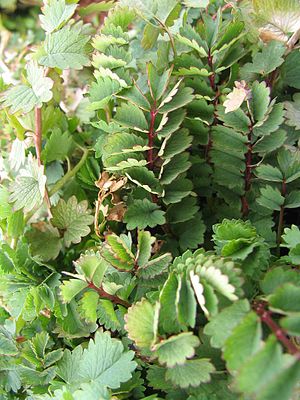
- Image via Wikipedia–Salad burnet leaves
Burnet is a hardy, perennial herb, Sanguisorba officinalis, that is a member of the rose family, Rosaceae. Native to Europe burnet is often called salad burnet, telling the reason for which it is usually grown. The leaves have a slightly nutty flavor and taste like cucumber. Also called European great burnet, it’s best eaten fresh. A closely related plant, S. minor, is like a small version and it’s called garden burnet or small burnet.
Burnet is cultivated in gardens in temperate regions of Europe, the United Kingdom and North America, but it’s not widely grown on a commercial-scale. The compound leaves have 7 to 15 pairs of small, round, toothed leaflets. The leafy stems grow close to the ground rising only a foot or so and reaching out over three feet. Separate flowering stalks grow a foot or two tall with terminal rose-colored flowers. Multiple flowers in compact oval heads are reddish-purple with four sepals that appear as petals.
Whole leaves are added to salads, eaten in sandwiches or used as a garnish for cold beverages. Chopped or minced leaves are a nice addition to mayonnaise-based salads, chilled soups and pasta dishes. Herb vinegars with burnet have a cool cucumber-like taste.
Burnet leaves taste like cucumber so they are used in dishes that would normally have cucumber in them. Cucumber has a tendency to release water into any dish that it’s in. Unless the food is consumed shortly after being made, the accumulation of water from cucumbers can ruin the dish. Substituting burnet will impart the flavor of cucumber without the watery mess. Use three tablespoons of fresh chopped leaves for each half cup of chopped cucumber.
Sprinkle a tablespoon or so of chopped leaves on top of stews, chili or any hot and spicy dish. The cucumber-like taste of the burnet will help to cool one’s mouth after eating spicy foods.
Being a perennial herb burnet can be harvested throughout the winter when it’s in a protected area. The leaves will remain green, but can become a little tough when exposed to the harshest weather. Harvest from the middle of the plant for the younger, more supple leaves.
Herbal tea made from the leaves was taken for fevers and to stop bleeding. The styptic properties were used historically by Europeans, colonial Americans during the Revolutionary War, and in Chinese traditional medicine. The genus name ‘Sanguisorba’ means to absorb bleeding, so the styptic properties helped to name the plant. It was believed that by drinking tea before battle that it would protect the wounded from bleeding to death. The presence of tannins may indeed reduce bleeding.
